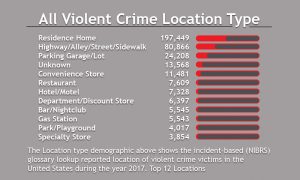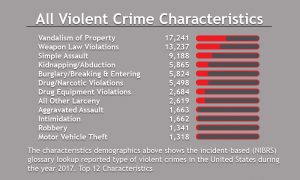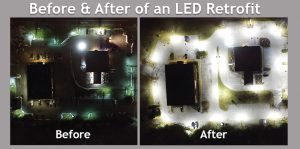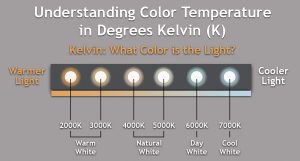— By Ted Stouch —
Parking area liability: are you vulnerable?

Ted Stouch, Action Services Group
In a retail or restaurant setting, a dark and foreboding parking lot or garage is a business owners’ worst nightmare. While a perfect setting for a horror movie, in real life, an unlit or poorly lit parking area is a recipe for disaster. Assault, robbery, rape and even murder are a few of the rampant occurrences plaguing parking areas across the U.S. They have low lighting, shadowy expanses and distractions, which make for a tempting invitation for criminals. According to a 2017 Office for Victims of Crime report, 35% of all aggravated assaults happen in a commercial place, parking lot or parking garage. Along with these disturbing assault statistics comes a host of other potential accidents just waiting to happen in under-lit parking areas.
Top 6 Parking Area Risks
 With new statistics showing women making or influencing 83% of all consumer spending in the U.S., a well-lit parking area has become a necessity for continued business success. A woman is 86% more likely than a man to bypass a dark parking area for a better illuminated one. There are thousands of articles offering advice on parking area safety: Park close to the store, make sure you’re under a light, don’t park in a dark garage…the list goes on and on. Predators are aware of the many distractions in and around these locations, which are often under patrolled, underlit and offer secluded areas to hide.
With new statistics showing women making or influencing 83% of all consumer spending in the U.S., a well-lit parking area has become a necessity for continued business success. A woman is 86% more likely than a man to bypass a dark parking area for a better illuminated one. There are thousands of articles offering advice on parking area safety: Park close to the store, make sure you’re under a light, don’t park in a dark garage…the list goes on and on. Predators are aware of the many distractions in and around these locations, which are often under patrolled, underlit and offer secluded areas to hide.
- Robbery
Historical data shows that more than 10% of all property crime occurred in parking areas, including lots and garages. Six percent of pickpocketing and purse snatching, as well as 80% of all shopping center crimes, occurred in a parking lot or parking garage. If you were a criminal looking to rob someone, an unlit parking area is going to be a prime location for your criminal exploits. By providing your customers with a well-lit parking area, you are subliminally advertising your organization’s desire to keep your customers safe while visiting your establishment.
- Kidnapping
 While coming to an exact statistic for this parking area risk is tricky, the FBI estimates 5,865 reported kidnappings or attempted kidnappings happening across the U.S. in 2017. On average, 90,000 people are missing in the U.S. at any given time, and no one wants to be the owner of a parking area from which someone is abducted or goes missing. You can deter parking area abductions by making sure your parking area is well lit and maintained.
While coming to an exact statistic for this parking area risk is tricky, the FBI estimates 5,865 reported kidnappings or attempted kidnappings happening across the U.S. in 2017. On average, 90,000 people are missing in the U.S. at any given time, and no one wants to be the owner of a parking area from which someone is abducted or goes missing. You can deter parking area abductions by making sure your parking area is well lit and maintained.
- Auto Theft
With 10% of all crimes happening in parking areas, auto theft is another dangerous risk. With an underlit parking area, you create the perfect auto theft location for criminals to frequent. If your parking area becomes notorious for auto theft, you can expect your customer traffic to slow to a crawl. By providing your customers with a well-lit parking area, you drastically lower the chances of them returning to an empty parking space where their car once was.
- Property Loss and Burglary
Most thieves target valuables and not life. Car owners who park in parking garages often are expected to be away from their vehicles for extended periods, such as at shopping malls. Add an unlit or underlit parking area, and the stage is set for thieves. Although adding additional light to your parking area will not 100% reduce the potential for crime, a well-lit parking area will improve the security and safety of your customers.
- Vehicle Accidents
A staggering 1 out of 5, motor vehicle accidents take place in a parking area, and 14% of all claims for auto damage involved collisions therein. A lot of these accidents are due to distractions, but with the addition of a poorly lit parking area, these stats could be much higher. In an NSC public opinion poll, 66% of drivers nationwide said they would make phone calls while driving through parking lots. Respondents also said they would: program GPS systems (63%), text (56%), use social media, (52%) send or receive emails, (50%) take photos or watch videos (49%). By offering a well-lit parking area, you are drastically reducing the chance of a driver not seeing another vehicle or pedestrian.
- Slip-and-Fall
Just like the previous five risks, this last one can happen even in a well-lit parking area, but you have a lower chance of having a lawsuit initiated against you. Due to the fact that any reasonable person could foresee someone slipping and falling due to not being able to see, if a customer has an accident in a parking area due to low or bad lighting, the business owner has a 40/60 chance of being sued and potentially paying out millions in compensation.
Shine Light on These Risks
 A well-lit parking area is not going to eliminate the risks above, but a bright, fully illuminated parking area will cut back on crime and liability. There are a few aspects to a well-lit parking area besides an abundance of lamps. As we review these three tips, keep in mind this is a general review for creating and maintaining a brightly illuminated parking area.
A well-lit parking area is not going to eliminate the risks above, but a bright, fully illuminated parking area will cut back on crime and liability. There are a few aspects to a well-lit parking area besides an abundance of lamps. As we review these three tips, keep in mind this is a general review for creating and maintaining a brightly illuminated parking area.
- Light Performance
Some of today’s most commonly used parking area lighting applications are Metal Halide, High Pressure Sodium and Mercury Vapor Lamps, which are all forms of High Intensity Discharge (HID) lamps. The performance characteristics of HID lamps can vary significantly, depending upon the type that is utilized in your facility. If your facility is utilizing High Pressure Sodium, you could be seeing a longer useful life than some of the other forms of HID due to slower lumen degradation. However, due to their fuel structure, they can produce an orange light with very low Color Rendering Index (CRI). The illumination produced by operating Metal Halide lamps will initially provide a white light, but with the accelerated lumen degradation common to Metal Halide lamps, the overall lifetime of your lamps will decrease and produce a pink illumination that barely provides light.
 There are substantial benefits to performing an LED retrofit to your organization’s parking area lighting. Light Emitting Diodes (LEDs) generate light utilizing a semiconductor and do not rely on the consumption of a fuel source like an HID lamp. Most LED fixtures utilize multi-point sources, which means the fixtures have multiple diodes with individual optics. When compared to the way HID fixtures distribute light, the results in illumination is more evenly distributed across a surface. As a result of an LED fixture’s multi-point design, you will see a bright, evenly distributed light pattern perfect for illuminating parking lots and exterior areas. The illumination across a given area will vary less and will eliminate the common bright spot produced by HID fixtures. In addition to your evenly displaced illumination, LEDs come in a variety of color temperatures providing a range of options in increasing the visual perception of brightness.
There are substantial benefits to performing an LED retrofit to your organization’s parking area lighting. Light Emitting Diodes (LEDs) generate light utilizing a semiconductor and do not rely on the consumption of a fuel source like an HID lamp. Most LED fixtures utilize multi-point sources, which means the fixtures have multiple diodes with individual optics. When compared to the way HID fixtures distribute light, the results in illumination is more evenly distributed across a surface. As a result of an LED fixture’s multi-point design, you will see a bright, evenly distributed light pattern perfect for illuminating parking lots and exterior areas. The illumination across a given area will vary less and will eliminate the common bright spot produced by HID fixtures. In addition to your evenly displaced illumination, LEDs come in a variety of color temperatures providing a range of options in increasing the visual perception of brightness.
- Maintenance
When it comes to parking area lighting, maintenance costs are always a big concern. Not only do you have to worry about the lamp’s lifetime, but these fixtures also require the use of a bucket truck or lift to change out the lamps and ballasts. If your organization does not have its own bucket truck or lift, you are forced to hire an outside contractor to maintain the exterior lighting in your facility. The expenses associated with HID lamps add up fast and over the course of 3 years, you could be looking at $1,200 in labor and materials to maintain a single parking area light fixture.
Due to the way LEDs generate light, their functional lifespan is much longer. An LED’s generated light output will degrade very slowly over time, and as a result, their functional lifespan can often exceed 100,000 hours. The LED’s lifespan drastically reduces the costs associated with maintaining your parking area lighting.
Below is a chart with the average rated life expectancy for different types of lamps. As a side note, when tested, these lamps are utilized at an expected usage rate. Extreme temperatures and continuously turning the lamp on/off can cause an accelerated ARL expectancy.

- Energy
Common HID lamps used in parking area lighting applications have a typical range of 100 watts to 1,000 watts, with the higher wattage producing higher light output. There are several factors that play a role in the number of wattages that are utilized, such as quantity, spacing and mounting height. A 400w or 1,000w HID fixture can cost between $200 and $500 to operate per lamp per year in electricity costs alone.
LED parking area lighting commonly utilize wattages between 40 watts (replacing 70 watt HID) and 400 watts (replacing 1000 watt HID), which often result in a 40% to 60% reduction in energy consumption. This could mean savings of up to $300 per fixture per year in electricity costs.
Luminous Efficancy is the output (lumens) of a light source divided by the total power input (watts). It is expressed in lumens per watt or lu/watt. Currently, you should be looking for an efficacy of no less than 70 lu/watt.
Determining Next Steps
When determining your next course of action, first consider what you are liable for, in regards to your parking area. If a slip-and-fall happens in your parking area, could the injured party retaliate with a lawsuit, because your lighting performance is sub-par? Are the lamps illuminating your parking area old and their lighting performance so diminished that you have low-lit shadowy expanses that provide cover for unsavory characters?
Once you review your parking area lighting, you have a choice. Will you continue to utilize outdated illumination, possibly costing you thousands, if not more? Or will you make the decision to retrofit to LED, providing a safe and well-lit parking area for your customers, staff and yourself?
— Ted Stouch is president and founder of Action Services Group, a national service provider offering a single point of contact for all your lighting, LED retrofit, electrical and signage needs. For more information on LED projects and products for your organization, contact Action Services Group: [email protected].
